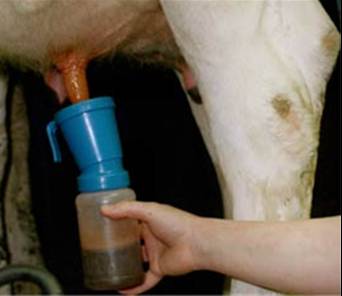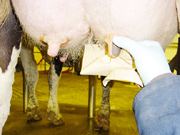Why Pre-Dip?
Pre-dipping is where you apply a disinfectant solution to the teat BEFORE milking, allow a 20 to 30 second contact time and then wipe dry. The aim is to end up with a clean dry teat to minimise the risk of clinical mastitis due to environmental bacteria such as E. coli, other coliforms and Strep. uberis. These bacteria are the most common cause of clinical mastitis in the UK, Europe and throughout the dairy world.
The environment is a reservoir of infection for the coliforms and Strep. uberis. Bacteria can enter the teats at three times:
- During the milking process if teats are dirty
- Immediately after milking if the cows lie down on dirty beds
- During the dry period when many teats remain open
Post-milking teat disinfection is where teats are disinfected AFTER milking to kill any bacteria which have been transferred onto the teats during the milking process. Every dairy herd must post-dip to control cell counts.
The idea of pre-dipping started in California where they found that improved teat cleanliness reduced levels of clinical mastitis and also reduced Bactoscan levels. Pre-dipping is now commonly practised on many farms – with great success – and is becoming more and more popular. A UK split herd trial, where half of the cows were predipped, showed a 57% reduction in clinical mastitis and a 70% reduction in Total Bacteria Count.
These results are not surprising. Attaching the milking unit onto a sanitised dry teat will reduce the risk of clinical mastitis. In some herds, dry wiping of teats to remove loose faecal matter is practised, whilst in other cases teats are washed and dried.
Contact time with a pre-dip is important as this allows the solution to soak into any dirt so it becomes much easier to remove. The contact time also allows the chemical to kill bacteria.
Many farmers also comment that teat skin condition improves when you predip and cows milk out far more fully and faster as you get a far better let-down reflex. This must have a positive effect on yield and reduce unit on-time.
Key points about pre-dipping:
- Dipping wets only the teat and is therefore better than spraying. If you spray, liquids can drain down from the udder onto the dried teat
- Allow a 20 to 30 second contact time to soften any dirt and facilitate chemical action
- You must wipe the teat dry to remove any dirt and avoid residues entering the milk
- Unlike a post dip applied after milking, predips must have a rapid speed of kill. Ensure you use an appropriate solution with a proven fast killing action
Graph showing 57% reduction in predipped trial group and 70% reduction in TBC






